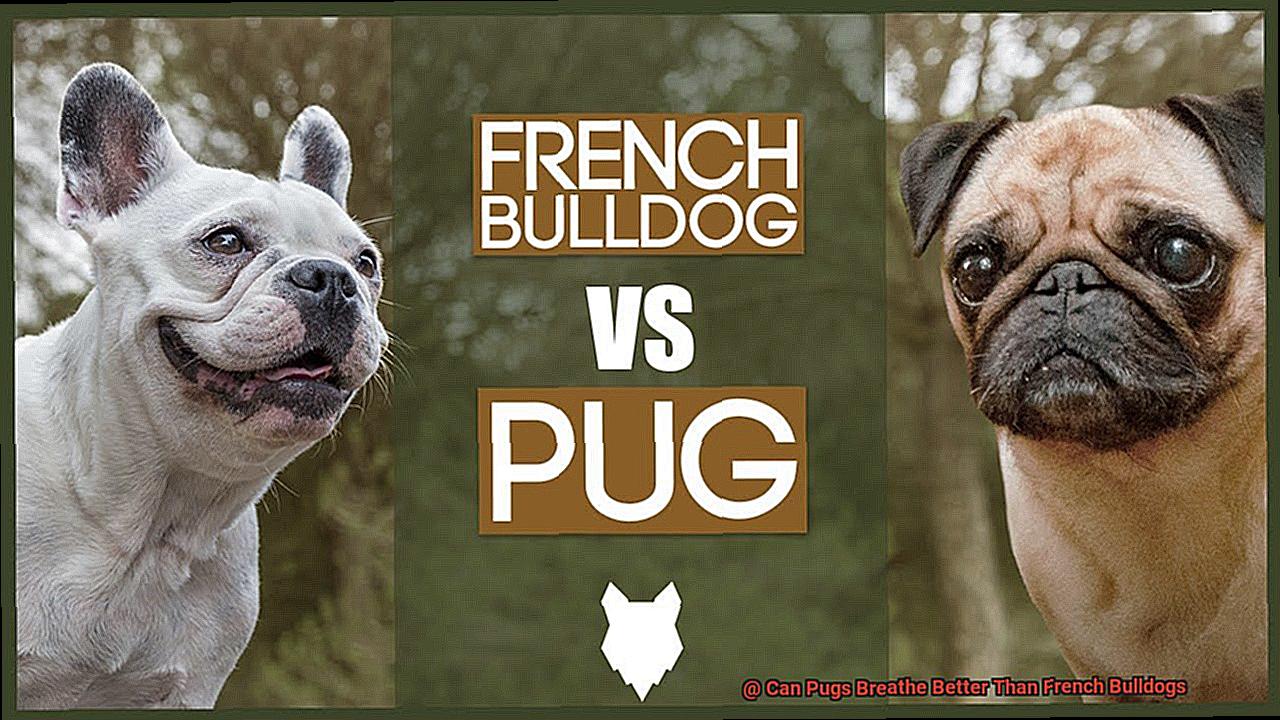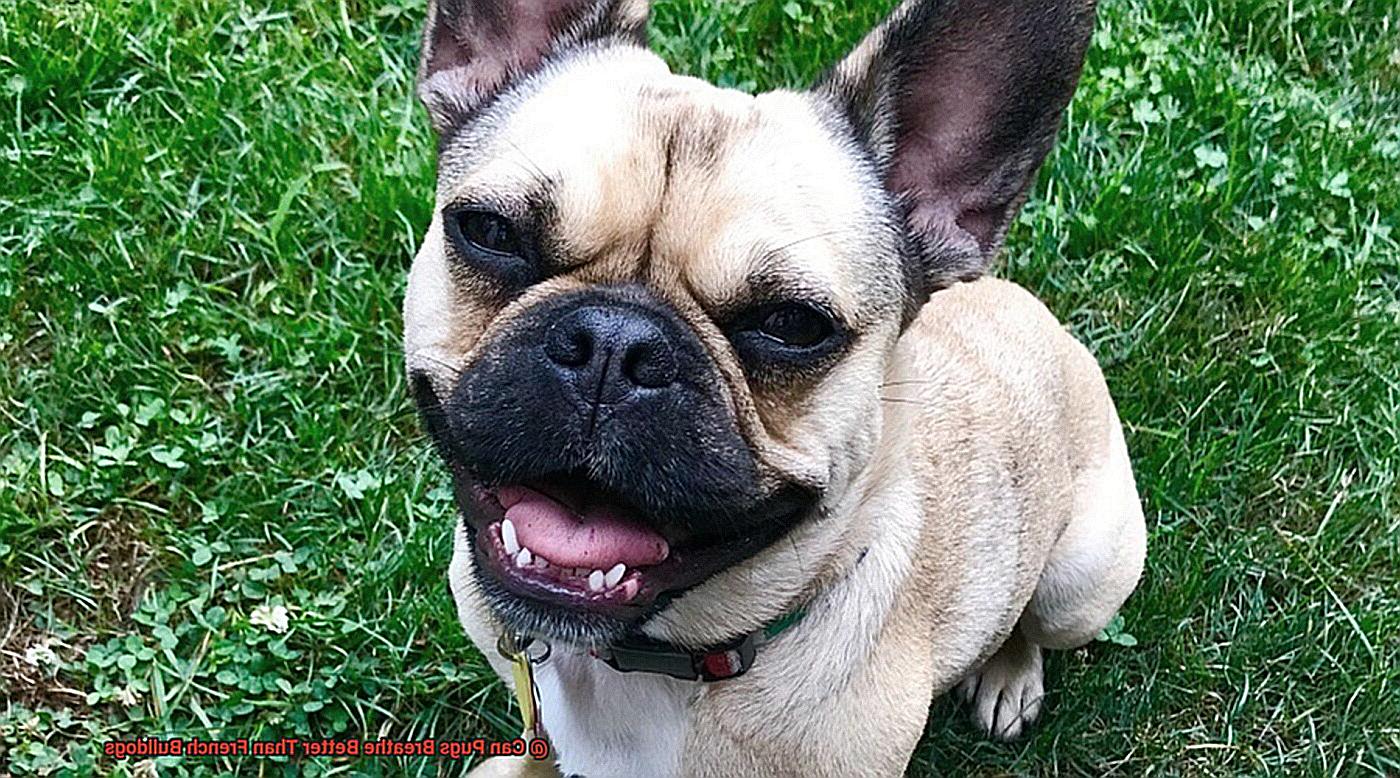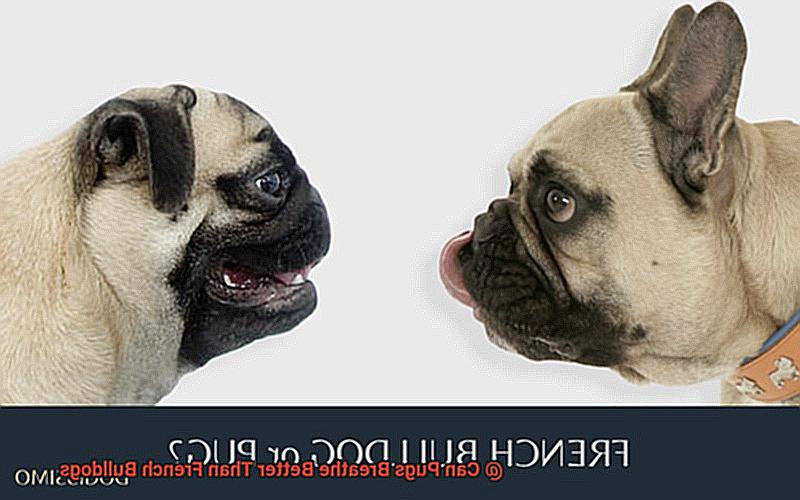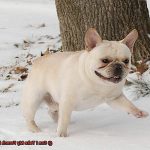Can Pugs Breathe Better Than French Bulldogs?
Today, we’re embarking on an adventure to uncover the truth about two of the most adorable and beloved breeds out there – pugs and French Bulldogs. We all know their squishy faces and playful personalities can make even the toughest hearts melt, but here’s the million-dollar question that keeps us up at night: Can pugs actually breathe better than French Bulldogs?
Breathing difficulties have become a hot topic when it comes to these flat-faced cuties, igniting passionate debates among dog lovers everywhere. As a self-proclaimed canine expert, I’m here to shed some light on this controversial issue. In this blog post, we’re going to dissect the unique characteristics of both pugs and French Bulldogs to unravel the mystery behind their respiratory abilities.
So grab yourself a cup of joe, cozy up with your furry companion, and get ready to dive headfirst into the captivating world of brachycephalic breeds. We’ll be exploring scientific facts, sharing heartwarming anecdotes, and seeking expert opinions to finally settle the score on which breed takes home the crown for better breathing – pugs or French Bulldogs.
Let’s get started on our quest for knowledge and put an end to this age-old debate once and for all.
Anatomy of Brachycephalic Breeds
Contents
- 1 Anatomy of Brachycephalic Breeds
- 2 Do Pugs Breathe Better Than French Bulldogs?
- 3 Respiratory Issues in Pugs
- 4 Respiratory Issues in French Bulldogs
- 5 Comparing the Breathing Abilities of Pugs and French Bulldogs
- 6 Factors That Affect the Breathing Abilities of Both Breeds
- 7 Tips for Ensuring Good Air Quality for Brachycephalic Breeds
- 8 Genetics and Overall Health Considerations for Pugs and French Bulldogs
- 9 Avoiding Excessive Exercise or Exposure to Extreme Temperatures
- 10 Conclusion
Brachycephalic breeds, such as French Bulldogs and Pugs, are beloved for their adorable flat faces and endearing personalities. However, their unique anatomy also poses certain challenges, particularly when it comes to their respiratory system. In this article, we will explore how the anatomy of brachycephalic breeds contributes to their increased risk of respiratory issues, focusing on the specific case of French Bulldogs. By understanding these challenges, you can better care for your furry friend and ensure their overall well-being.
Anatomy of Brachycephalic Breeds:
Skull Structure:
- Brachycephalic breeds have shortened skulls, resulting in a compressed upper airway.
- This compression affects the size and shape of the nasal passages and windpipe, making them narrower compared to non-brachycephalic breeds.
Elongated Soft Palate:
- French Bulldogs often have elongated soft palates, which can obstruct their airways and make breathing difficult.
- The soft palate is the tissue at the back of the throat that separates the oral and nasal cavities. When elongated, it can partially block airflow.
Narrow Nostrils:

- Another common anatomical feature in French Bulldogs is narrow nostrils (stenotic nares).
- Narrow nostrils restrict the amount of air that can flow through the nose, further exacerbating breathing difficulties.
Do Pugs Breathe Better Than French Bulldogs?
While both Pugs and French Bulldogs share similar respiratory challenges, there may be slight differences in their breathing abilities due to variations in their anatomy:
Nasal Length:
- Pugs generally have a slightly longer nose compared to French Bulldogs.
- A longer nose may allow for slightly better airflow and less restriction in the nasal passages.
Individual Variations:
- It’s important to note that there can be significant variations in the severity of breathing problems among individual dogs within each breed.
- Factors such as genetics, overall health, weight, and lifestyle can influence their breathing abilities.
Caring for Your French Bulldog:
Regular Veterinary Check-ups:
Maintain a Healthy Weight:
Environment and Lifestyle Considerations:
- Provide a suitable living environment with good air quality, avoiding exposure to extreme temperatures.
- Limit strenuous exercise, especially in hot weather, as brachycephalic breeds are more prone to heat exhaustion.
Respiratory Issues in Pugs
Brachycephalic breeds like pugs and French Bulldogs have captured the hearts of dog lovers worldwide with their squishy faces and big, expressive eyes. But behind their adorable appearance lies a potential source of concern – respiratory issues. These breeds are characterized by a short snout and a flattened face, which can lead to various breathing difficulties. Let’s dive deeper into the respiratory challenges faced by our beloved pugs.
Brachycephalic Airway Obstruction Syndrome (BAOS): A Breath of Struggle
One common respiratory issue in pugs is Brachycephalic Airway Obstruction Syndrome (BAOS). This condition occurs when the airway becomes obstructed due to the shape of the pug’s skull and soft tissues in the throat. Just imagine trying to breathe through a narrow straw – it’s no walk in the park. Symptoms of BAOS may include loud snoring, difficulty breathing, and excessive panting. If you notice these signs, it’s essential to consult your veterinarian for proper diagnosis and management.

Elongated Soft Palate: When Breathing Hits a Roadblock

Another respiratory challenge for pugs is an elongated soft palate. The soft palate is the tissue at the back of the roof of the mouth, and in pugs, it can be longer than usual. This elongation partially blocks the airway, making it harder for pugs to catch their breath. Imagine running with a sock stuck in your throat – not exactly a pleasant experience. Surgical correction may be necessary to improve breathing and enhance your pug’s quality of life.
Stenotic Nares: Nostrils That Need a Little More Wiggle Room
Pugs may also experience stenotic nares, which refers to narrow nostrils. These snub-nosed cuties may have nostrils that resemble tiny slits rather than wide openings. Narrow nostrils restrict airflow, making it harder for pugs to take in the oxygen they need. This condition is often present from birth and may require surgical correction to widen the nostrils and alleviate breathing difficulties.
Heatstroke: A Pug’s Achilles’ Heel
Due to their respiratory challenges, pugs are at a higher risk of heatstroke. Their short snouts make it harder for them to cool down by panting efficiently, which can lead to overheating in hot weather or during vigorous exercise. Imagine wearing a winter coat in the scorching sun – not a pleasant thought. As responsible pug parents, it’s crucial to keep our furry friends cool, provide shade, and avoid strenuous activities during peak temperatures.
Respiratory Issues in French Bulldogs
French Bulldogs are beloved for their charming appearance, but their distinctive features also come with a unique set of challenges. In this article, we will delve into the respiratory issues commonly faced by French Bulldogs, including Brachycephalic Airway Syndrome (BAS), stenotic nares, and laryngeal collapse. We will also discuss the importance of proactive care and provide tips for ensuring your furry friend can breathe easy.
Brachycephalic Airway Syndrome (BAS):
- BAS is a collection of anatomical abnormalities that restrict airflow in the upper airways.
- Common abnormalities include narrowed nostrils, elongated soft palate, and a narrow trachea.
- Symptoms include difficulty breathing, excessive panting, snoring, and noisy breathing.
- To manage BAS, surgical interventions like rhinoplasty or soft palate resection may be necessary.


Stenotic Nares:
- Stenotic nares refer to narrowed or collapsed nostrils, which further obstruct the airflow.
- This condition can exacerbate breathing difficulties, especially during physical activity or in hot weather.
- Surgical correction of stenotic nares can significantly improve breathing function.
Laryngeal Collapse:
- Weak or collapsed cartilage in the larynx can cause further obstruction in the airway.
- Laryngeal collapse may lead to increased difficulty in breathing and should be addressed promptly by a veterinarian.
- Depending on the severity, treatments can range from lifestyle modifications to surgical interventions.
Heatstroke Risk:
- French Bulldogs are more susceptible to heatstroke due to their compromised ability to cool themselves through panting.
- Owners should provide a cool and well-ventilated environment, limit intense exercise in hot weather, and monitor their dog’s breathing patterns closely.
Comparing Pugs and French Bulldogs:
- Both pugs and French Bulldogs share similar skull structures and respiratory challenges.
- However, individual cases may vary, and the severity of respiratory issues can differ between breeds.
- Consulting with a veterinarian is crucial to understanding your specific dog’s needs and managing their respiratory health effectively.
Comparing the Breathing Abilities of Pugs and French Bulldogs
When it comes to comparing the breathing abilities of pugs and French Bulldogs, it’s important to understand that both breeds face respiratory challenges due to their brachycephalic features. These adorable pups may have a short, pushed-in nose and a flat face, but unfortunately, this can lead to breathing difficulties.
Similarities:
- Brachycephalic Airway Syndrome: Both pugs and French Bulldogs are prone to Brachycephalic Airway Syndrome, which encompasses a range of respiratory issues. These include snorting, wheezing, snoring, and difficulty breathing, especially during exercise or in hot weather.
- Narrow Nostrils: Both breeds often have narrower nostrils, which can restrict airflow and make breathing more difficult.
Differences:
- Severity of Breathing Difficulties: Pugs tend to have more pronounced breathing difficulties compared to French Bulldogs. This is because pugs often have narrower nostrils and a more obstructed airway, making it harder for them to breathe properly.
- Nostril Width: French Bulldogs typically have wider nostrils compared to pugs, allowing for better airflow. This slight advantage can make a difference in their overall breathing abilities.
- Muzzle Length: French Bulldogs usually have a longer muzzle compared to pugs. This longer muzzle can contribute to improved breathing by providing more space for air to flow through.
Proactive Care Tips:
To ensure the well-being of both pugs and French Bulldogs, there are several proactive care tips that can be followed:
- Avoid Strenuous Exercise in Hot Weather: Both breeds should avoid strenuous exercise or activities in hot weather, as this can exacerbate their breathing difficulties.
- Provide a Cool and Well-Ventilated Environment: It’s important to provide a cool and well-ventilated environment for these dogs, especially during hot weather. This can help them breathe more comfortably.
- Maintain a Healthy Weight: Keeping these breeds at a healthy weight is crucial for their respiratory health. Excess weight can further burden their already compromised breathing abilities.
Surgical Interventions:
In some cases, surgical interventions may be necessary to improve the breathing abilities of pugs and French Bulldogs. Procedures such as nasal enlargement or correction of elongated soft palates can be performed by veterinarians to help open up the airway and make breathing easier for these dogs.
Understanding the Challenges:
Potential owners of pugs and French Bulldogs should be aware of the breathing challenges associated with these breeds. This knowledge can help them make an informed decision when choosing a dog and also prepare them for the care and attention these dogs may require.
Factors That Affect the Breathing Abilities of Both Breeds
Today, we’re diving into the fascinating world of pugs and French Bulldogs and exploring the factors that impact their breathing abilities. These adorable breeds may steal your heart with their squishy faces and charming personalities, but it’s important to understand the challenges they face due to their brachycephalic features. So, grab a cup of coffee and let’s get started.
The Brachycephalic Dilemma:
Imagine running a marathon with a straw in your mouth – that’s what pugs and French Bulldogs experience daily. Both breeds have short skulls and pushed-in noses, which can lead to breathing difficulties. This brachycephalic structure is undeniably cute, but it comes with its fair share of challenges.
Nostril Nightmares:
Narrow nostrils, also known as stenotic nares, are a common issue in pugs and French Bulldogs. These little snuffleupaguses struggle to get enough air through their tiny nasal passages, making it harder for them to breathe comfortably.
Soft Palate Struggles:
Ever heard of the phrase “it’s all in the back of your throat”? Well, that rings true for our furry friends too. Both pugs and French Bulldogs can have elongated soft palates, which are tissues at the back of the throat that separate the airway from the digestive system. When these tissues become too long or thick, they obstruct the airway and make breathing a challenge.
The Narrow Trachea Trouble:
If you thought narrow nostrils were bad enough, think again. Pugs and French Bulldogs can also have narrow tracheas, which further restricts the airflow into their lungs. It’s like trying to inhale through a tiny straw – not an easy feat, my friends.
The Laryngeal Collapse Conundrum:
Picture this – you’re taking a deep breath, and suddenly, your larynx collapses inward. Scary, right? Well, that’s exactly what happens to some pugs and French Bulldogs. Laryngeal collapse occurs when the cartilage in the larynx weakens and obstructs the airway during inhalation, making breathing even more difficult.
Weight Woes:
We all love spoiling our furry friends with treats, but it’s essential to keep their weight in check. Obesity can worsen breathing difficulties in both pugs and French Bulldogs, as excess pounds put additional strain on their already compromised respiratory systems.
The Heat is On:
Just like us, pugs and French Bulldogs struggle to handle hot and humid weather. Their brachycephalic structure makes it difficult for them to regulate their body temperature, which can lead to overheating and worsen their breathing difficulties.
Tips for Ensuring Good Air Quality for Brachycephalic Breeds
French Bulldogs are adorable and lovable companions, but their unique facial structure can make it challenging for them to breathe. As a responsible owner, it is crucial to prioritize good air quality to promote the health and well-being of your furry friend.
In this article, we will explore essential tips to ensure optimal air quality for your French Bulldog.
Create a Clean and Dust-Free Living Space:
Regular cleaning is key to maintaining a clean environment for your French Bulldog.
Vacuuming and dusting help remove allergens and irritants that can exacerbate breathing difficulties. Pay extra attention to areas where dust tends to accumulate, such as carpets, curtains, and furniture. Consider using pet-friendly cleaning products to avoid any potential irritants.
Control Temperature and Humidity Levels:
Extreme temperatures can be particularly challenging for brachycephalic breeds like French Bulldogs. Ensure that your home is comfortably regulated with proper temperature and humidity levels. Use air conditioning or fans during hot weather to prevent overheating, and provide warm blankets or jackets during colder months to keep them cozy.
Maintain Proper Ventilation:
Adequate airflow is crucial for your French Bulldog’s respiratory health. Ensure good ventilation in your home by opening windows or using fans to promote fresh oxygen flow. Consider installing air purifiers to remove any pollutants or stale air, keeping the living space fresh and clean.
Avoid Irritants in the Environment:
French Bulldogs are sensitive to irritants such as cigarette smoke, strong cleaning products, perfumes, and certain types of candles. These can further aggravate their breathing difficulties. Opt for pet-friendly alternatives or minimize their usage altogether to maintain good air quality for your four-legged friend.
Exercise Wisely:
Regular exercise is vital for your French Bulldog’s overall well-being, but it’s important to be mindful of their respiratory limitations. Engage in low-intensity exercises and avoid excessive exertion to prevent respiratory distress during physical activity. This could include gentle walks or interactive play sessions that allow them to stay active without overexerting themselves.
Maintain a Healthy Weight:
Obesity can worsen breathing problems in brachycephalic breeds, so it is crucial to keep your French Bulldog at a healthy weight. Provide a balanced diet with appropriate portion sizes and consult your veterinarian for guidance on their specific dietary needs. Regular exercise, combined with a healthy diet, will help your furry friend maintain optimal weight and contribute to better respiratory health.
Genetics and Overall Health Considerations for Pugs and French Bulldogs
When it comes to genetics and overall health, pugs and French Bulldogs have some unique considerations. Both breeds are known for their adorable flat faces, but this can also lead to certain health issues, particularly related to their breathing.
- Skull Shape: Pugs have a more exaggerated brachycephalic structure compared to French Bulldogs. This means that pugs have a shorter snout and a more compressed airway passage. On the other hand, French Bulldogs have a relatively longer snout, allowing for a slightly larger airway opening.
- Nostril Size: Pugs typically have narrower nostrils compared to French Bulldogs, which can further restrict their airflow. This narrowness can make it challenging for pugs to take in enough oxygen, especially during physical activity or in hot weather conditions.
- Overall Health: Both pugs and French Bulldogs are prone to respiratory issues due to their brachycephalic features. They can suffer from brachycephalic airway syndrome (BAS), which includes conditions like stenotic nares (narrow nostrils) and elongated soft palate. Pugs may also be susceptible to laryngeal collapse and everted laryngeal saccules.
It’s important to note that the severity of these respiratory issues can vary from dog to dog. Some pugs may experience more severe breathing problems than others, while some French Bulldogs may have relatively fewer issues. Regular veterinary check-ups and proactive measures to promote respiratory health are crucial for both breeds.
Avoiding Excessive Exercise or Exposure to Extreme Temperatures
In the battle of the snorters, pugs and French Bulldogs face unique challenges when it comes to breathing. Their adorable flat faces might win hearts, but their brachycephalic anatomy makes it harder for them to take in oxygen. To ensure their respiratory health, owners of these lovable pups must be mindful of their exercise levels and exposure to extreme temperatures.
Exercise Management:
- Monitor Activity Levels: Keep a close eye on your pug or French Bulldog’s activity levels and avoid overexertion. Excessive exercise can strain their already compromised respiratory system and lead to symptoms like wheezing, coughing, and excessive panting.
- Be Mindful of Weather Conditions: Hot and humid weather can be particularly challenging for brachycephalic breeds. Limit exercise during peak temperatures and opt for cooler times of the day. Provide plenty of shade and fresh water during outdoor activities.
Extreme Temperature Precautions:
- Heatstroke Prevention: Pugs and French Bulldogs are more susceptible to heatstroke due to their breathing difficulties. Ensure they have access to shaded areas, well-ventilated indoor spaces, and always carry water during outings.
- Cold Weather Considerations: Very cold temperatures can also pose risks for brachycephalic breeds. Protect your furry friend with dog sweaters or jackets to keep them warm during winter walks, reducing the risk of respiratory distress.
Rest and Recovery:
- Regular Breaks: During exercise or playtime, allow your pug or French Bulldog to rest and catch their breath regularly. This helps prevent overexertion and gives their respiratory system time to recover.
- Consult a Specialist: Seek guidance from a veterinarian who specializes in brachycephalic breeds. They can provide valuable advice tailored to your dog’s specific needs and health condition.
Conclusion
In conclusion, when it comes to breathing, pugs have the upper paw compared to French Bulldogs.
With their shorter snouts and wider nostrils, pugs are naturally better equipped for efficient airflow. Their respiratory system allows them to take in oxygen more easily, reducing the risk of respiratory distress and overheating.
On the other hand, French Bulldogs, with their compact faces and narrower airways, tend to struggle more with breathing. This can lead to a range of health issues and make them more prone to heat exhaustion.
So if you’re looking for a breed that excels in the breathing department, pugs are the clear winners.




